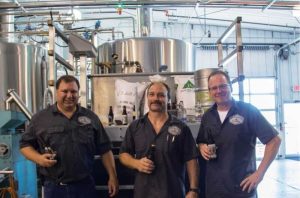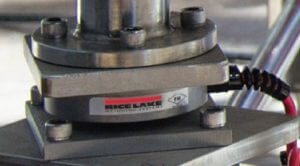When the sound of polka music is getting louder and the smell of sauerkraut is getting stronger, you can only be at one place: Oktoberfest; and where there is an Oktoberfest, there is bound to be a giant pumpkin weighing contest. On a sunny, fall day in Chippewa Falls, Wis., the competition was heating up. Giant pumpkin growers from around the northern Midwest gathered to weigh their pumpkins, celebrate their hard work and dream of one day breaking the world record of 2,323 pounds.
Chad Gehweiler, Giant Pumpkin Weigh-Off organizer and avid pumpkin grower, reached out to his friend Brian Potter of WIScale for a certified scale. According to the Great Pumpkin Commonwealth (GPC), the regulating body for giant fruits and vegetables, a certified scale “is the single most important item you need at your weigh-off.” Each site requires a 4 X 4 foot (or larger) platform scale with a current certification sticker that has been calibrated by a licensed weights and measurement business. Guinness World Records requires that certification to qualify for an official world record. Potter immediately knew what scale could handle half-ton and heavier pumpkins: Rice Lake’s RoughDeckfloor scale. Potter says, “The RoughDeck has a low profile with a lot of steel; it’s very industrial.” Accompanying the RoughDeck was the 480 Legend Series digital weight indicator. Designed for protection in dirty, wet environments, the 480 scale indicator withstands higher levels of electrical noise, power disturbances and transient spikes than its predecessors. Two serial ports with local/remote function connect with ease to displays like the LaserLight Series. Packed with power but economically priced, the 480 is ruggedly durable and easy to pair with any scale or display.
An accurate scale was only one part of the competition. Entries included tomatoes, long gourds, watermelons, field pumpkins and of course, the guaranteed crowd pleaser, giant pumpkins. The crowd, gathered from all over Oktoberfest, wanted to see what mattered most to them: the numbers. Using the LaserLight Series remote display, large bright red digits wowed the onlookers; first with a five pound tomato. Then, the numbers grew with a 125 pound watermelon, a 141.5 pound field pumpkin and finally, a 1,479 pound giant pumpkin.
Using a skid steer and a homemade harness, each pumpkin was delicately lifted one by one like a newborn baby being placed in their mother’s arms. In a dramatic turn of events, it was discovered a stem had broken off of one contender’s pumpkin at the patch. According to the Great Pumpkin Commonwealth, the stem was no longer eligible to be weighed with the pumpkin. Just to add salt to the wound, event organizers weighed the stem after the pumpkin’s weight was officially entered into the Great Pumpkin Commonwealth’s database; a solid 2.5 pounds. For those hoping to break a world record, 2.5 pounds easily separates first and second place.
Other regulations regarding the competition included each pumpkin being inspected and measured by a site judge. There can be no holes in the pumpkin nor can it be manipulated to weigh heavier. All data is tracked by the Great Pumpkin Commonwealth and prize money can range anywhere between $1,000 and $30,000, depending on the size and location of the competition.
Gehweiler recommends three things for those hoping to one day grow giant pumpkins: hard work, organic soil additives and carefully selected seeds. It may come as a surprise, but giant pumpkin seeds are bred much like prize horses or dogs. They are identified by their grower’s last name, the weight of the pumpkin it was bred from, as well as the weight and year grown of the male pollinator plant and the female seed it was grown from. Buyers can purchase seeds via the Internet or through personal connections with prices varying anywhere between $10 a seed to $1,600 a seed. In addition to choosing the right seeds, Gehweiler also recommends using natural soil boosters and dry, organic fertilizers from The GreenGro™ in Windsor, Calif. “At the end of the day,” Gehweiler says, “these pumpkins are all trained to grow a certain size and pattern.” The Great Pumpkin Commonwealth is also an excellent resource for a beginner’s journey into giant pumpkin cultivation. They give advice on site selection, soil, seeds, transplantation, plant care, watering and finally, rules and regulations regarding certified weigh-offs.
The GPC recommends starting in late May when the frost has passed and daytime temperatures will stay above 75 degrees Fahrenheit for three or four months. Before planting, dig the soil about a foot deep and mix in some compost, manure or natural root system boosters like those sold by The GreenGro. Plant two or three seeds in a group about one inch apart from one another.
The idea is to keep the soil moist, but not wet. Once your pumpkin seeds sprout and have three leaves, remove all but the strongest plant. Add more fertilizer and when three baby pumpkins are about six inches in diameter, choose the best-shaped one and pick off the other two. All of the vine’s nutrients will now feed into one potential giant pumpkin. Train the vines away from the pumpkin and once the primary vine reaches 20 feet, pinch off the tips and the side shoots to avoid crushing the pumpkin. Fertilize your pumpkin about every two weeks while still watering it regularly. The last two to three weeks of September is when growth slows down and your pumpkin is ready to be taken off the vine and entered in an official GPC weigh-off.
In addition to weighing giant pumpkins in the Midwest, Rice Lake’s RoughDeck and 480 digital weight indicator have been on hand for competitions across the country. Farm Y’all, a farm-to-fork festival in Cullman, Ala., witnessed a state record breaking pumpkin of 1,296 pounds and the Vermont State Fair saw a winning pumpkin at 956 pounds, both weighed with the dynamic RoughDeck and 480 duo.
Gehweiler has claimed the Wisconsin state record with a pumpkin weighing 1,882 pounds at Pumpkinmania! in Sturgeon Bay, Wis. Persistent hard work, the right seeds and the best soil additives continue to aid Gehweiler’s quest for the ultimate giant pumpkin as he hopes to one day break the world record. No matter the shape, texture or appearance of the pumpkin, the one thing growers work hardest for is the weight. Just like the dedicated giant pumpkin grower, no scale works harder than Rice Lake’s.
Click here to download the story



